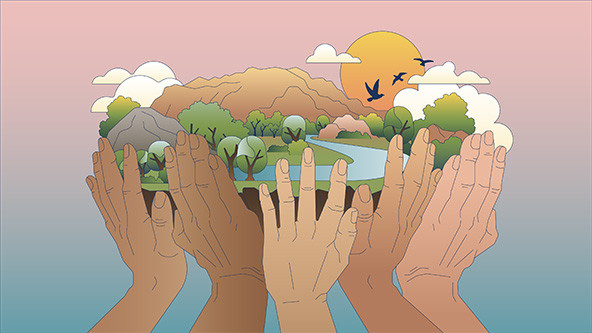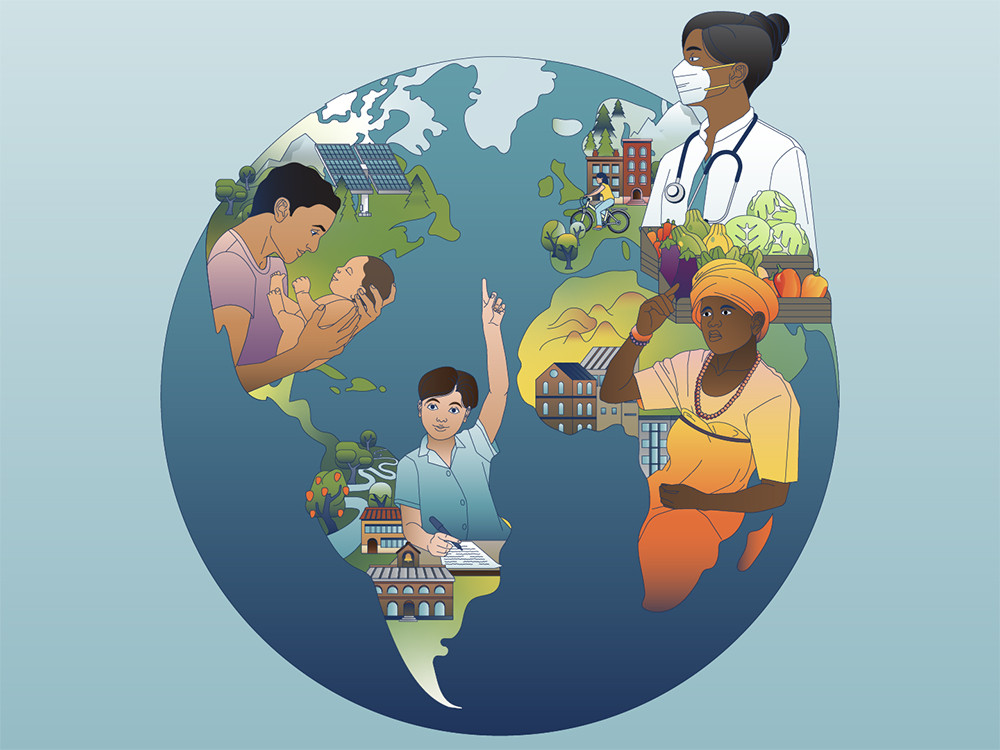 (Illustration courtesy of the Robert Wood Johnson Foundation)
(Illustration courtesy of the Robert Wood Johnson Foundation)
We live in an interesting time. A movement against facing the truth of US history and acknowledging the existence of systemic racism is sweeping through many parts of our country. Colonization is embedded in that history—European settlements of the 17th and 18th centuries are referred to as colonies. The original inhabitants of what is now the United States migrated to this region between 40,000 to 14,000 years ago. It is these first peoples who are Indigenous and became what we now call American Indian/Alaska Native peoples in the United States and First Nations populations in Canada. Indigenous Peoples have oral histories that confirm eons of existence in relationship with place, and we should be respectful that many Indigenous cultures have their own belief systems regarding creation and the origins of their populations.
For Indigenous Peoples of the Americas, the creation of borders that have been imposed upon tribal nations has led to a tremendous loss of land, natural resources, culture, food systems, language, economies, and a thousand generations of traditional knowledge.

In the face of these adversities, Indigenous Peoples of the Americas still exist, and many of our communities are healing and thriving. I was fortunate to grow up in a family with many traditional healers and cultural leaders. As a physician and public health professional, these formative traditional values and beliefs have guided my personal journey toward promoting equity. And, if we are ever to achieve equity, we must walk through truth, even when it is difficult or challenging.
This series of essays lifts up the idea of learning across borders. While solutions often have no borders, unfortunately problems operate the same way. Colonizers brought both arbitrary borders and a whole host of problems to Indigenous communities in the Americas. Despite this and because of the resilience of Indigenous peoples, they are developing solutions to benefit their communities and maybe even those surrounding them.
What’s In a Name?
Races and ethnicities in the United States are defined by the Office of Management and Budget (OMB). For the 2020 Census, the racial categories included: White; Black or African American; Asian; Native Hawaiian or Other Pacific Islander; and American Indian or Alaska Native (AI/AN). OMB defines AI/AN as a “person having origins in any of the original peoples of North and South America (including Central America) and who maintains tribal affiliation or community attachment.” Within the United States, some Indigenous groups are not American Indian. For example, the Alaskan Inuit, or Iñupiaq, and Yupik peoples, are not American Indian cultural groups. Rather, they are a circumpolar culture with populations in Siberia, Alaska, Canada, and Greenland. However, some Indigenous Alaskans are also “American Indian” cultural groups. For example, the Athabascan populations in central Alaska are part of a larger cultural and linguistic group that extends to the coast of California and into the Southwest (e.g., Navajo and Apache tribes are ethnolinguistically Athabascan). Hence, we use the racial category “American Indian or Alaska Native.”
My people, the Očhéthi Šakówiŋ Oyate’ (People of the Seven Council Fires), are comprised of three large tribal groups, the Lakota, Dakota, and Nakota nations. Our traditional homelands extend from the central plains of the United States well into what is now Canada. The Dakota are the eastern-most tribal group of the Oyate’, and, hence, were the first group of my people encountered by colonizers. Because colonization came from the east, the Dakota Territory was so named and became the states of North and South Dakota. It is remarkable that, in my experience, many people do not realize that “Dakota'' is a tribe. The arbitrary borders that separate the United States, Canada, and Mexico were created by colonizers, and these borders have divided a multitude of tribal nations, including my own. Numerous Oyate’ communities are located in what is now Canada. To our southern border, the Tohono O’odham Nation lies on what is now the US-Mexico border, and villages and peoples exist on both sides of the colonizers’ border.
Communities and Economies
In looking beyond borders, there is much to learn from Indigenous Peoples—populations with extensive diversity across cultures, languages, and systems of governance. One common element among North American Indigenous groups is the communitarian societal structure—everyone has a role, our individual gifts are appreciated, and everyone matters. In communitarian systems, the deep-rooted connection between individuals and the broader community creates a social identity and character that are largely shaped by these relationships with the community. A much smaller emphasis is placed on individualism. As a result, the “greater good” of relationships and priorities is focused on community benefit rather than personal gain. A deep-rooted and spiritually based connection among people, the earth, and all living creatures provides a model for leadership that would result in tremendous benefits to modern society.
Black Elk, a Lakota traditional healer who lived in the late 1800s and early 1900s, was one of the American Indians who went to Europe as part of Buffalo Bill’s Wild West Show. In the book Black Elk Speaks by John Niehardt, he says of the economic conditions in Europe:
I could see that the Wasichus [Europeans] did not care for each other the way our people did before the nation’s hoop was broken. They would take everything from each other if they could, and so there were some who had more of everything than they could use, while crowds of people had nothing at all and maybe were starving. They had forgotten that the earth was their mother.
In addition to differences in governance and leadership principles, the economies of Indigenous societies were distinct from those of Europeans. Traditionally, Indigenous Peoples lived in a “real economy” based on trade and actual value—there was no currency or cash (an artificial proxy for value). Today’s currency system, with nothing tangible backing up our money except our collective belief in it, is a truly foreign idea from an Indigenous perspective.
Current measurements of poverty commonly used to assess social determinants of health include concepts such as financial income and home or land ownership. Regarding income, without an historic concept of money or currency, the financial system imposed on the Americas from Europe was not only a foreign concept, but culturally inappropriate. We continue to observe across generations significant challenges with ongoing poverty and difficulties related to money management because these are relatively new concepts for Indigenous Peoples.
Capitalism is also at odds with communitarian principles that tend to redistribute wealth into our complex family networks.
Another measure of poverty and wealth is owning land or owning a home. Historically, Indigenous Peoples of North America generally did not have a concept of owning the earth. And many Indigenous societies did not have individual permanent dwellings or homes, opting instead for communal living in seasonal settings or mobile forms of shelter. As a result, American Indians were at greater risk for loss of access to land, territory, and natural resources based on significant cultural misalignments. Traditional Indigenous belief systems focused on living in harmony with nature, whereas European-based beliefs focused on ownership of and dominance over land by individuals and the government.
The dramatic changes Europeans imposed on Indigenous economies have led to relatively higher unemployment rates, lower incomes, less home ownership, and intergenerational poverty. Solutions need to include bi-directional engagement and opportunities to learn from each other. Contemporary US society could learn from Indigenous approaches to caring for the earth and each other and promoting intact, sustainable ecosystems. For Indigenous Peoples at the micro-level, education on money management and economics would assist individuals in navigating modern society. At the macro-level, we need to promote economic development in tribal communities, respect tribal sovereignty while encouraging private sector investment, and improve data collection and evaluation methodologies to more accurately measure outcomes.
A multitude of examples of successful Indigenous economic development exist, including the Brokenhead Ojibwe Nation in Manitoba. They participate in the First Nation Land Management Act that promotes local jurisdiction over the use of their land, and they have developed a tribal land code that promotes economic development that is consistent with local culture and values.
Resilience, Strengths, and Wise Practices
The resilience of Indigenous populations in North America is reflected in the expansion of awareness of key social issues (e.g., Missing and Murdered Indigenous Women and the impact of Indian boarding schools); the increased use of Indigenous land acknowledgments by universities, government agencies, and the private sector; and the growth in academic programs focused on Indigenous health. There’s also an increase in the number of Indigenous Peoples in academics and leadership positions. This translates into Indigenous knowledge and principles being incorporated into public health, academic, and policy settings.
For example, in public health and other disciplines, we are taught to use evidence-based practices. My question is, “Whose evidence is it?” If a program is effective in Atlanta or Boston, does that mean it will be effective in a tribal community in South Dakota? A “one-size-fits-all” approach is likely to yield inconsistent results if the local community and cultural contexts are not incorporated.
In Canada and the United States, we are seeing expansion of the idea of a wise practices approach—not just evidence-based practices. In a wise practices model, we incorporate local knowledge, culture, language, and values into program design and implementation. Local values and priorities can also be incorporated into evaluation to ensure that the local context is a formal component of determining program success. Incorporating local priorities and vernacular will improve community engagement and increase community acceptance of programs.
The Harvard Project on American Indian Economic Development started in the 1980s and examined why some tribes were realizing economic development and financial success. Unfortunately, most tribes were living in poverty. Their research showed that economic success was deeply influenced by social and political factors. Tribal economic development is dependent on the community structure, systems, and institutions; it requires a holistic approach. The research showed that the most successful communities exercise sovereignty and have a cultural match between institutions and traditional values—a wise practices approach. For example, the Family Spirit program at the Johns Hopkins Center for Indigenous Health is an evidence-based program that is successful in promoting maternal and child health in American Indian and Alaska Native communities because the program is malleable and incorporates local language, culture, and practices.
Indigenous Determinants of Health
In recent years, there’s a broad recognition of the importance of the social determinants of health, including measures such as poverty and educational attainment. Much of the focus has been on health and economic disparities through a deficits-based approach. However, Indigenous Peoples and cultures hold many strengths. I was honored to be part of an international team of Indigenous scholars that developed the Indigenous Determinants of Health document for the United Nations Permanent Forum on Indigenous Issues in April 2023. These include the vital roles of our relationship with the earth and each other, the health protective effects of cultural connection and sense of belonging, and the intergenerational perspective on life. We take strength in knowing that previous generations prayed for our well-being, and we are responsible for future generations. Our actions today will directly influence the health of the planet and its inhabitants. Modern society could greatly benefit from learning Indigenous values that promote sustainability and respect for the earth and for each other.
To achieve equity, we must walk through truth, even when it is difficult. Part of that truth is understanding and embracing the truth of our collective history of colonization. Learning across borders means respecting diverse cultures and practices and making wise decisions when developing solutions to improve outcomes. The well-being of future generations—our grandchildren—depends on it. Mitakuye Oyasin. All my Relations.
Support SSIR’s coverage of cross-sector solutions to global challenges.
Help us further the reach of innovative ideas. Donate today.
Read more stories by Donald Warne.

